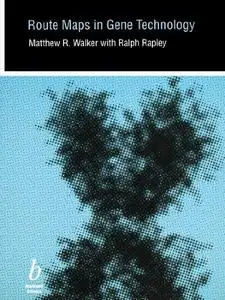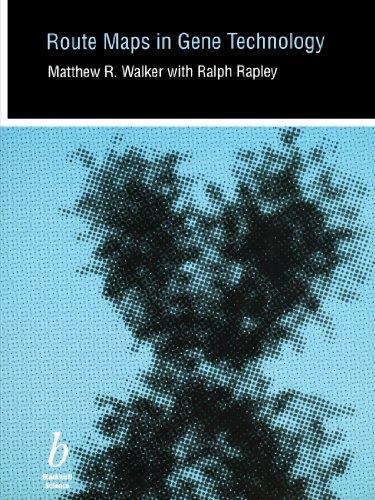Route Maps in Gene Technology By Matthew R. Walker, Ralph Rapley(auth.)
1997 | 333 Pages | ISBN: 063203792X | PDF | 71 MB
1997 | 333 Pages | ISBN: 063203792X | PDF | 71 MB
Route Maps in Gene Technology is an exciting new introductory textbook for first-year undergraduates in molecular biology and molecular genetics. The subject is broken down into 140 to 150 key concepts or topics, each of which is dealt with in one doublepaged spread. These range from basic introductory principles to applied topics at the cutting edge of research. A control strip along the top of the page shows the student which pages need to have been read beforehand and which topics may be followed afterward. In addition, at the front of the book are a selection of 'routes,' which the student or teacher may choose in order to study a particular topic. Because courses have become more 'modular' and many students arrive at college with little or no biology background, this approach enables teachers and students to structure a course of study to best suit their disparate exposure to biology. An exciting new concept in textbook design, allowing unparalleled flexibility on the part of the student and the teacher Covers the full range of modern molecular biology, from basic principles to the latest applications Attractive, clear and simple presentation with copious two-colour illustrations Content: Chapter 1 The Concept of Genes is Developed (pages 10–11): Chapter 2 Genes are Located to Chromosomes (pages 12–13): Chapter 3 Genes are Composed of DNA (pages 14–15): Chapter 4 The Chemical Building Blocks of Nudeic Acids (pages 16–17): Chapter 5 Formation of the DNA Double Helix (pages 18–19): Chapter 6 Packaging of DNA within Cells (pages 20–23): Chapter 7 Chromatin Structure and the Functional Activity of Genes (pages 24–25): Chapter 8 Types and Functions of DNA?Protein Interactions (pages 26–27): Chapter 9 Organisation of Genomes into Multiple Chromosomes (pages 28–29): Chapter 10 Distribution of Nucleic Acids within Eukaryotic Cells (pages 30–31): Chapter 11 Types of RNA Molecules (pages 32–33): Chapter 12 The Anatomy of Eukaryotic Chromosomes (pages 34–35): Chapter 13 The Organisation of Genes within Chromosomes (pages 36–39): Chapter 14 The Molecular Anatomy of Eukaryotic Genes (pages 40–43): Chapter 15 Chromosome Aberrations and Human Disease (pages 44–45): Chapter 16 Type of Mutations and their Effects (pages 46–47): Chapter 17 Forms of Chemically Altered DNA (pages 48–49): Chapter 18 DNA Repair Mechanisms (pages 50–51): Chapter 19 Linkage Analysis (pages 52–53): Chapter 20 Pedigree Analysis and Modes of Inheritance (pages 54–55): Chapter 21 Genes Dictate the Nature of Proteins (pages 56–57): Chapter 22 The Nature of the Genetic Code (pages 58–61): Chapter 23 Transcription: Forming Genetic Messages (pages 62–63): Chapter 24 Post?Transcriptional Processing of Messenger RNA (pages 64–67): Chapter 25 Transfer and Ribosomal RNA Processing/Modification (pages 68–69): Chapter 26 Mechanisms Regulating Gene Expression (pages 70–71): Chapter 27 Transcriptional Regulatory Sequences (pages 72–73): Chapter 28 Operons and Prokaryotic Control of Gene Expression (pages 74–75): Chapter 29 Transcription Factors and Gene Expression (pages 76–77): Chapter 30 In vivo Translation: Decoding Genetic Messages (pages 78–81): Chapter 31 Sequences Involved in Cellular Protein Targeting (pages 82–83): Chapter 32 Eukaryotic Cell Division: Mitosis and Meiosis (pages 84–87): Chapter 33 Molecular Mechanisms of Cell Cycle Control (pages 88–89): Chapter 34 Genetic Recombination Mechanisms (pages 90–91): Chapter 35 Gene Transfer during Bacterial Reproduction (pages 92–93): Chapter 36 Transposable Genetic Elements: Transposons (pages 94–97): Chapter 37 In vivo DNA Replication (pages 98–101): Chapter 38 Genetic Control of Development (pages 102–105): Chapter 39 The Natural Biology of Bacteriophages (pages 106–107): Chapter 40 Bacteriophage Genetics (pages 108–111): Chapter 41 Recombinant DNA Technology (pages 112–113): Chapter 42 Enzymes Commonly used in Molecular Biology Methods (pages 114–115): Chapter 43 Restriction Endonucleases (pages 116–117): Chapter 44 Restriction Fragment Length Polymorphisms (pages 118–119): Chapter 45 Isolation of Nucleic Acids from Cells and Tissues (pages 120–123): Chapter 46 Visualising Nucleic Acids (pages 124–125): Chapter 47 Electrophoresis of Nucleic Acids (pages 126–127): Chapter 48 In vitro Hybridisation (pages 128–129): Chapter 49 Types of Hybridisation Assay Formats (pages 130–131): Chapter 50 Southern Blotting (pages 132–133): Chapter 51 In situ Hybridisation (pages 134–135): Chapter 52 Measuring Transcriptional Activity via Messenger RNA (pages 136–137): Chapter 53 Converting Messenger RNA into Complementary DNA (pages 138–139): Chapter 54 Methods for Determining DNA Nucleotide Sequences (pages 140–143): Chapter 55 The Polymerase Chain Reaction (pages 144–147): Chapter 56 Alternatives to PCR?Based in vitro DNA/RNA Amplification (pages 148–151): Chapter 57 In vitro Translation Methods (pages 152–153): Chapter 58 Types and Methods of Gene Probe Generation (pages 154–155): Chapter 59 Chemical Synthesis of Oligonucleotides (pages 156–159): Chapter 60 Types and Applications of Nucleotide Analogues (pages 160–161): Chapter 61 Methods for Labelling Gene Probes (pages 162–165): Chapter 62 Fundamental Principles of Cloning (pages 166–167): Chapter 63 The Nature of Cloning Vectors (pages 168–169): Chapter 64 Inserting Foreign DNA into Vectors (pages 170–171): Chapter 65 The Development of Bacteriophage Vectors (pages 172–175): Chapter 66 Plasmids: Development as Cloning Vectors (pages 176–179): Chapter 67 Yeast?Derived Plasmid Vectors (pages 180–181): Chapter 68 Phagemids, Hybrid Phage and Plasmid Vectors (pages 182–183): Chapter 69 Vectors for Use in Plant and Animal Cells (pages 184–185): Chapter 70 Delivering DNA into Cells (pages 186–187): Chapter 71 Principal Genomic and cDNA Cloning Strategies (pages 188–191): Chapter 72 Strategies for Identifying Desirable Recombinant Clones (pages 192–193): Chapter 73 Gene Mapping Techniques (pages 194–197): Chapter 74 Detecting DNA–Protein Interaction Sites (pages 198–201): Chapter 75 Detecting Promoter and Enhancer Sequences (pages 202–203): Chapter 76 Methods for Identifying Protein?Encoding Regions (pages 204–207): Chapter 77 Genetic Fingerprinting (pages 208–209): Chapter 78 Analysing Ancient DNA (pages 210–211): Chapter 79 In vitroMutagenesis Methods (pages 212–215): Chapter 80 Genetically Modified Micro?Organisms (pages 216–217): Chapter 81 Genetically Engineered Plants (pages 218–219): Chapter 82 Genetically Engineered Animals (pages 220–221): Chapter 83 Molecular Techniques in Prenatal Diagnosis (pages 222–223): Chapter 84 The Genetics of Cystic Fibrosis (pages 224–227): Chapter 85 The Dystrophin Gene and Muscular Dystrophies (pages 228–231): Chapter 86 Identifying the Gene for Huntington's Disease (pages 232–233): Chapter 87 Lipoprotein Genes and Coronary Heart Disease (pages 234–235): Chapter 88 The Detection of Microbial Infections (pages 236–237): Chapter 89 Molecular Biology of Human Immunodeficiency virus and AIDS (pages 238–241): Chapter 90 Engineering Microbial Bioluminescence (pages 242–243): Chapter 91 Recombinant DNA Methods in vaccine Development (pages 244–245): Chapter 92 Receptors and Cellular Signalling Mechanisms (pages 246–249): Chapter 93 Oncogenes and the Molecular Basis of Cancer (pages 250–253): Chapter 94 Molecular Diagnosis and Therapy of Cancers (pages 254–255): Chapter 95 Drug Development using Recombinant DNA Approaches (pages 256–257): Chapter 96 Protein Engineering (pages 258–261): Chapter 97 Immunoglobulin Genetics (pages 262–265): Chapter 98 Genetic Engineering of Recombinant Antibodies (pages 266–269): Chapter 99 Current Approaches to Gene Therapy (pages 270–271): Chapter 100 The Human Genome Mapping Project (pages 272–275):



